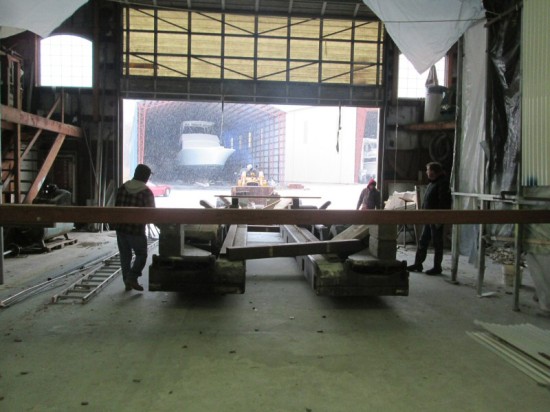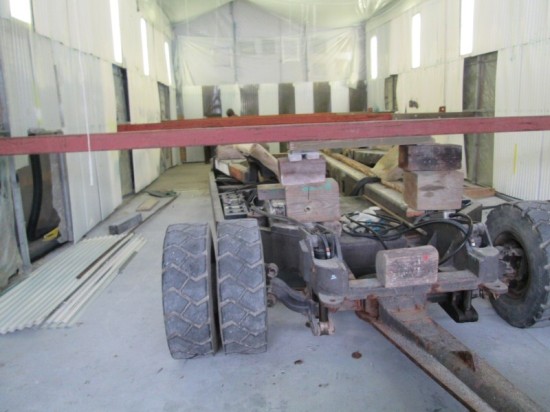I actually made it in but forgot to abort the auto post. I made it about 8 but the 3 others that arrived starting filtering in around 9ish. About 16 degrees right now and quite windy. I don’t think I’m leaving the office unless it is to go home!
This photo was taken about 3:30 Tuesday afternoon and you can’t see in the photo, the wind was blowin’ and the snow was a flyin’.

We spent a good portion of the day on Tuesday moving the paint tent forward to accommodate a 49 foot boat. This took about all available personnel. Just moving it ahead about 10 foot and adding some plastic to the newly created gap we will be able to do some bigger boats in. Of course height is still a determining factor.

In the photo above you can see the snow falling!
 The Power of Google
The Power of Google
While searching for something totally unrelated, I did find an interesting article at the
Boat Test site.
Most Boats Sink at the Dock! – 05/16/2007
Tips on preventing launching disasters
Some boaters may be in for a rude surprise when they find their boat sinks at the dock just after being put in the water. After combing through the BoatU.S. Marine Insurance claims files for the most common causes of springtime sinking, Seaworthy’s Editor Bob Adriance has the following tips for boaters:
- Hose clamps: Winterizing an engine in the fall often requires the removal of coolant hoses. But sometimes boaters are in a rush and the hoses aren’t reattached and clamped properly. Adding to this, cramped engine boxes mean that the hoses and the clamps holding them sometimes can’t be visually inspected easily. In the spring you’ll need to ensure all of the hose clamps are securely tightened in place.
- Hoses: During the winter as the water inside them freezes, some hoses can lift off their attached seacock. However, with spring’s warmer temperatures the water now returns to a liquid, and if the seacock was left open last fall, water can pour into the bilge. Double clamping with marine-rated stainless hose clamps, inspecting hose attachment locations, or keeping seacocks closed can save you from a spring sinking.
- Spring rains: Just 100 gallons of water weighs over 800 pounds so a boat with low freeboard only needs to sink a few inches before cockpit scuppers submerge and water starts to enter the boat. Larger boats with cracked or improperly caulked fittings that are located just above the waterline can also inadvertently let water in when they become submerged. Ensure that rain rolls off the boat and not into it.
- Sea strainer: For inboard/outboard and inboard powered boats, if not properly winterized the intake sea strainer can freeze over the winter, cracking or bending the inspection bowl. And if the seacock was left open the boat will sink as soon as ice in the strainer thaws or the boat is put in the water. Always inspect the strainer for cracks or other damage.
- Stuffing Box: On powerboats or sailboats with inboard power, if the stuffing box’s packing material that seals the prop shaft is not tight, a steady drip will slowly swamp a boat. Also remember that no stuffing box should leak when the prop shaft is not moving. Stuffing boxes need to be inspected routinely, regardless of the season.
You may want to make checking some of these items a work order item before spring rolls around!
 We spent a good portion of the day on Tuesday moving the paint tent forward to accommodate a 49 foot boat. This took about all available personnel. Just moving it ahead about 10 foot and adding some plastic to the newly created gap we will be able to do some bigger boats in. Of course height is still a determining factor.
We spent a good portion of the day on Tuesday moving the paint tent forward to accommodate a 49 foot boat. This took about all available personnel. Just moving it ahead about 10 foot and adding some plastic to the newly created gap we will be able to do some bigger boats in. Of course height is still a determining factor.
 In the photo above you can see the snow falling!
In the photo above you can see the snow falling!
 The Power of Google
While searching for something totally unrelated, I did find an interesting article at the Boat Test site.
The Power of Google
While searching for something totally unrelated, I did find an interesting article at the Boat Test site.

